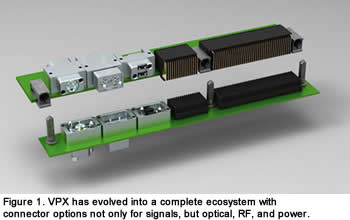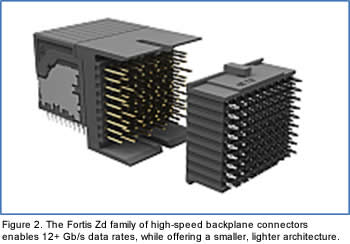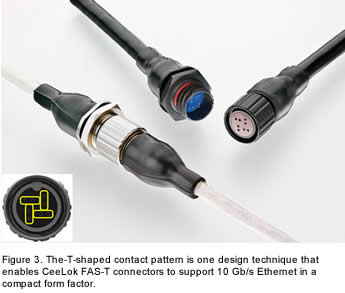Rugged Connectors in Embedded Computing
The relentless evolution of modern military and aerospace equipment is driving the need for higher performance embedded computers. These computers must process enormous amounts of information in real time, so they need bandwidth, both inside the box and in input/output connections for box-to-box connectivity. Many designers whose systems are operating at 3.125 Gb/s with architectures like VPX are planning for the next step to 6.25 Gb/s, and the cutting edge of the rugged embedded computing industry are looking at 10 Gb/s and beyond. Beyond sheer bandwidth, additional concerns are meeting the SWaP (size, weight, and power) goals of doing more computing in less space and with less power consumption.
Advances in computers for rugged applications depend in part on the ability of interconnections to provide signal integrity as data rates increase. Equally important, they must maintain signal integrity in application environments with shock, vibration, severe temperature excursions, and other hazards that commercial connectors can’t withstand. Connectors for high-speed ruggedized systems present a unique combination of electrical and mechanical engineering challenges. TE Connectivity has focused on these challenges and introduced numerous products to empower the designer to successfully deploy the most powerful of rugged embedded computers.
Inside the Box
 While legacy architectures like VME and CompactPCI are still used in aerospace and defense, the rugged embedded computing industry has moved onward and upward using VPX and next-generation COTS interconnects as the vehicles of evolution. TE has developed a comprehensive suite of VPX-related interconnects, including the ubiquitous MULTIGIG RT2 backplane connector, used in applications from helicopter avionics to tank vetronics. The modular connector is the standard for VITA 46 VPX and is supplemented by VITA 62 and the MULTIBEAM XLE power supply connector, the VITA 66 fiber-optic modules and SMPM-based VITA 67 multiposition RF modules. Similarly, the Mezalok mezzanine connector was developed for VITA 61 XMC 2.0, improving signal integrity and mechanical reliability for XMC architects.
While legacy architectures like VME and CompactPCI are still used in aerospace and defense, the rugged embedded computing industry has moved onward and upward using VPX and next-generation COTS interconnects as the vehicles of evolution. TE has developed a comprehensive suite of VPX-related interconnects, including the ubiquitous MULTIGIG RT2 backplane connector, used in applications from helicopter avionics to tank vetronics. The modular connector is the standard for VITA 46 VPX and is supplemented by VITA 62 and the MULTIBEAM XLE power supply connector, the VITA 66 fiber-optic modules and SMPM-based VITA 67 multiposition RF modules. Similarly, the Mezalok mezzanine connector was developed for VITA 61 XMC 2.0, improving signal integrity and mechanical reliability for XMC architects.
While the aerospace and defense industries are strong markets for high-reliability standards-based solutions such as VPX, a wide variety of applications are emerging that demand more — more flexibility, more density, more pins, more speed, and more mechanical robustness. To fill this gap, the Fortis Zd backplane connector provides an unprecedented combination of electrical and mechanical performance. Created through the synthesis of commercial and defense technologies, the Fortis Zd connector offers the reliability of the Mini-Box contact, while enabling 12+ Gb/s data throughput per differential pair. Available in single ended and differential configurations, the modular and scalable connector comes in 6- and 9-row versions to enable a variety of card pitches. While the Fortis Zd connector represents a huge step forward for the rugged embedded computing community, it is compatible with many existing components, such as the previously cited VPX suite of components, TE’s Universal Power Module, various guide hardware, and more. With the depth and breadth of board-level products available to rugged embedded computer architects, the environment inside the box has never been better.

I/O is Faster, Too
While fiber optics may be considered by many to be the ultimate in I/O solutions, copper cable assemblies are certainly not vanishing. In many instances, copper can outperform fiber economically and in adverse environments. Past practices of using non-impedance-matched construction have been giving way to designers engineering matched-impedance, end-to-end solutions.
 As data rates continued to escalate, matched-impedance construction began in relatively rudimentary ways. At first, architects began to take non-impedance-matched connectors, like a 38999 or ARINC pin field, and emulate an impedance-matched design through signal/ground allocation. This was followed by the Quadrax contact, a relatively rugged, but still somewhat unsophisticated step in matched-impedance data paths. This technology is now giving way to highly impedance-matched designs, purpose-built to maintain signal integrity, while enabling reduced SWaP.
As data rates continued to escalate, matched-impedance construction began in relatively rudimentary ways. At first, architects began to take non-impedance-matched connectors, like a 38999 or ARINC pin field, and emulate an impedance-matched design through signal/ground allocation. This was followed by the Quadrax contact, a relatively rugged, but still somewhat unsophisticated step in matched-impedance data paths. This technology is now giving way to highly impedance-matched designs, purpose-built to maintain signal integrity, while enabling reduced SWaP.
The Data Dart quad-style, high-speed contact system is capable of reaching 10 GbE performance. The contact system is integrated into EN4165-style connectors for the In-Flight Entertainment market, with concepts being developed for 38999 and subminiature-D connectors for military and space applications.
Additional examples of the new design practice are found in the CeeLok FAS-T connector and the Deutsch MAX I/O GbE connector. The CeeLok FAS-T connector is a 100-ohm connector with an insert featuring an optimized “T”-shaped contact configuration. The connector was primarily targeted at Ethernet, enabling both 1 GbE and 10 GbE with its 8-contact insert arrangements. However, the connector can also carry many other 100-ohm protocols, such as USB or IEEE 1394. The connector is smaller and lighter than Quadrax solutions, while also being smaller and much more robust than modular plug and jack-based solutions. The Deutsch MAX I/O GbE connector is similar in concept to the CeeLok FAS-T connector, but features a modular insert that is scalable, enabling higher pin or channel counts.
Both of these connectors were designed to withstand the rigors of adverse environments found in aerospace and defense embedded computers. They are sealed, made with pin and socket contacts, field reparable and tested to extended levels.
For lighter-duty gigabit applications, RJ45 modular plugs and jacks still work well, provide moderate resistance to vibration, and have been adapted to D38999-style shells for IP67 sealing to protect against dust and fluids.
End-to-End Solutions
 Faster embedded computers require faster I/O to realize the full benefits of increased data rates. At high speeds, connector and cable must be carefully matched. This leads many engineers to prefer to specify either cable assemblies (which have factory-certified performance) or to specify connectors and cable designed to operate together from the same vendor. This approach not only avoids finger-pointing, but it narrows the vendor list.
Faster embedded computers require faster I/O to realize the full benefits of increased data rates. At high speeds, connector and cable must be carefully matched. This leads many engineers to prefer to specify either cable assemblies (which have factory-certified performance) or to specify connectors and cable designed to operate together from the same vendor. This approach not only avoids finger-pointing, but it narrows the vendor list.
Even with global sourcing, many companies still prefer to keep their supplier list short. The preference is to work with a lesser number of broad-based suppliers than with a large number of specialty limited-focus companies. As a result, an interconnect supplier offering a broad portfolio streamlines the supply chain, as well as provides the integrator a more direct technical path to end-to-end solutions.
Gregory Powers serves as market development manager for the electronic systems and space segments within the Global Aerospace, Defense & Marine business unit of TE Connectivity. He received a BSME from Syracuse University, has completed numerous graduate-level studies, and holds two patents relative to optical datacom devices. Connect with Greg Powers at www.DesignSmarterFaster.com.

